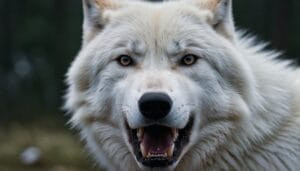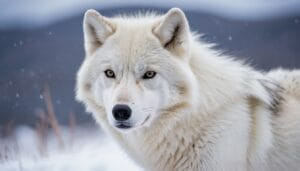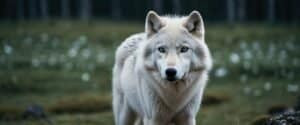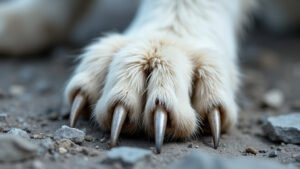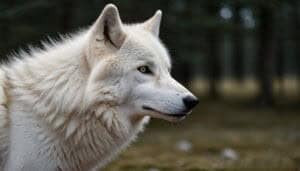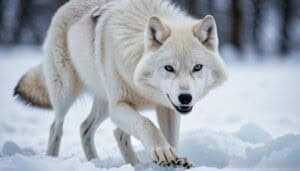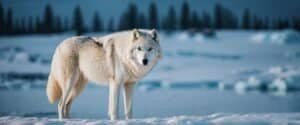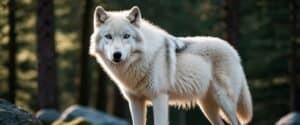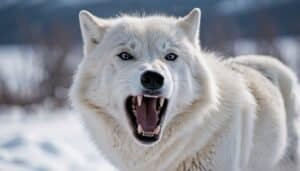Introduction
In this article, we will explore the fascinating characteristics and vital functions of the Arctic wolf’s undercoat. We’ll begin by defining what the undercoat is and examining its composition and structure, highlighting the differences between the undercoat and the outer coat
Next, we’ll delve into the crucial roles the undercoat plays in maintaining body heat and protecting the skin in extremely cold temperatures, discussing its insulating properties and material composition
We’ll also cover the seasonal and evolutionary adaptations of the undercoat, including how it changes throughout the year and its historical evolution to benefit the Arctic wolf in its harsh environment
Additionally, we’ll compare the Arctic wolf’s undercoat to those of other wolves, examining the specific adaptations that enable survival in Arctic conditions, and explore how the undercoat affects the wolf’s hunting behavior and mobility
Finally, we’ll investigate the synergy between the undercoat and the outer coat, focusing on the mechanisms of thermal insulation and how these two layers interact to provide optimal protection against the cold
Through this comprehensive analysis, you’ll gain a deeper understanding of the Arctic wolf’s remarkable adaptations to its environment
What is the Arctic Wolf’s Undercoat?
The Arctic wolf’s undercoat is a dense, insulating layer of fur located beneath the outer coat. This undercoat is crucial for the wolf’s survival in the frigid Arctic climate
Unlike the outer coat, which consists of longer, coarser guard hairs, the undercoat is made up of shorter, finer hairs that trap air close to the wolf’s skin, providing an essential layer of warmth
Composition and Structure of the Undercoat
The composition of the Arctic wolf’s undercoat is specialized to offer maximum insulation. It is made up of a high density of fine, crimped hairs that create a fluffy, wool-like texture. This texture is excellent for trapping air, which is a poor conductor of heat, thereby creating a thermal barrier that keeps the wolf warm
Types of Fibers in the Undercoat
The undercoat is composed primarily of two types of fibers: downy hairs and intermediate hairs. Downy hairs are the finest and most numerous, forming the bulk of the undercoat and providing the primary source of insulation. Intermediate hairs are slightly coarser and help to support the structure of the undercoat, adding to its effectiveness in retaining heat
Properties of the Undercoat Materials
The materials of the undercoat are not only fine and dense but also possess excellent water-resistant properties. This water resistance is crucial, as it prevents the wolf’s skin from becoming wet and losing heat more rapidly. Additionally, the natural oils produced by the wolf further enhance the water-repellent properties of the undercoat
Differences Between the Undercoat and the Outer Coat
While the undercoat provides insulation, the outer coat serves a different, yet complementary, purpose. The outer coat consists of longer, coarser guard hairs that protect the undercoat from snow, ice, and moisture. These guard hairs are less dense than the undercoat hairs, allowing the wolf to shed snow and water more efficiently
Protective Role of the Outer Coat
The guard hairs of the outer coat are vital for protecting the undercoat and the skin from the elements. They act as a first line of defense against wind and precipitation, ensuring that the insulating properties of the undercoat are not compromised
This dual-layered fur system allows the Arctic wolf to maintain its body heat even in the most extreme weather conditions
Interaction Between the Undercoat and Outer Coat
The interaction between the undercoat and the outer coat is a perfect example of nature’s engineering. The guard hairs shield the undercoat, which in turn traps heat close to the body. This synergy between the two layers ensures that the Arctic wolf remains warm, dry, and capable of thriving in the severe cold of its natural habitat
Functions and Adaptations of the Arctic Wolf’s Undercoat
The Arctic wolf’s undercoat is more than just a layer of fur; it is a vital component of the wolf’s survival strategy. In this section, we will explore how the undercoat helps maintain body heat, protects the skin in low temperatures, and the specific materials and properties that make it so effective
How Does the Arctic Wolf’s Undercoat Help Maintain Body Heat?
Insulating Function of the Undercoat
The primary function of the undercoat is to insulate the wolf’s body against the extreme cold of the Arctic. The fine, dense hairs trap air close to the skin, creating a layer of warm air that acts as a thermal barrier. This trapped air prevents the loss of body heat, ensuring that the wolf remains warm even when external temperatures plummet
Heat Retention in Extreme Climates
In addition to trapping air, the undercoat also helps in retaining heat generated by the wolf’s metabolism. The dense structure of the undercoat reduces the amount of heat lost to the environment, which is crucial during long, cold Arctic nights
This efficient heat retention mechanism allows the wolf to conserve energy and maintain its core body temperature, which is vital for its survival and functionality
Skin Protection in Low Temperatures
Barrier Against Extreme Cold
The undercoat also serves as a protective barrier for the wolf’s skin against the extreme cold. By providing a thick, insulating layer, it prevents the cold air from coming into direct contact with the skin. This is essential in preventing frostbite and other cold-related injuries that could impair the wolf’s ability to hunt and move
Prevention of Skin Freezing
The fine hairs of the undercoat, combined with the natural oils produced by the wolf, create a water-resistant layer that keeps moisture away from the skin. This water resistance is crucial because wet fur loses its insulating properties and can lead to rapid heat loss. By keeping the skin dry, the undercoat ensures that the wolf’s body heat is preserved and its skin is protected from freezing
Materials and Properties of the Undercoat
Types of Fibers in the Undercoat
The Arctic wolf’s undercoat is composed of different types of fibers, primarily downy hairs and intermediate hairs. Downy hairs are the finest and most numerous, creating a soft, dense layer that is excellent at trapping heat. Intermediate hairs are slightly coarser and provide additional structure and support to the undercoat
Properties of the Undercoat Materials
The materials of the undercoat are inherently adapted to provide maximum insulation. The fine, crimped structure of the downy hairs creates a high surface area that enhances the trapping of air and retention of body heat
Additionally, the natural oils produced by the wolf coat the undercoat hairs, making them water-resistant. This water resistance is vital for maintaining the insulating properties of the undercoat, especially when the wolf is exposed to snow and ice
Seasonal and Evolutionary Adaptations of the Undercoat
The Arctic wolf’s undercoat is not static; it adapts to seasonal changes and has evolved over time to meet the challenges of its environment. This section will explore how the undercoat changes throughout the year and the evolutionary adaptations that make it so effective
Changes in the Undercoat Throughout the Year
Seasonal Adaptations of the Undercoat
The Arctic wolf’s undercoat undergoes significant changes with the seasons. During the harsh winter months, the undercoat becomes thicker and denser to provide maximum insulation against the extreme cold. This increased density helps the wolf maintain body heat and survive the long, dark Arctic winters
As the seasons change and temperatures rise, the undercoat adjusts accordingly. In spring and summer, the wolf sheds much of its dense undercoat to prevent overheating. This shedding process, known as molting, allows the wolf to stay cool while still retaining some insulating properties to protect against cooler nights and sudden weather changes
Shedding of the Undercoat in Different Seasons
The molting process is an essential adaptation that helps the Arctic wolf regulate its body temperature throughout the year. In spring, the wolf begins to shed its thick winter undercoat, often rubbing against trees and rocks to help remove the excess fur. This shedding process can take several weeks and results in a much lighter, thinner undercoat that is better suited for the warmer months
During the fall, the undercoat starts to grow back in preparation for the winter. This regrowth ensures that the wolf has a thick, insulating layer ready to protect it against the upcoming cold. The cyclical nature of shedding and regrowth is a vital adaptation that allows the Arctic wolf to thrive in an environment with extreme seasonal variations
Evolutionary Adaptations of the Undercoat
Evolutionary History of the Undercoat
The Arctic wolf’s undercoat is the result of thousands of years of evolutionary adaptation. Over generations, wolves that developed thicker, more insulating undercoats were better able to survive and reproduce in the harsh Arctic environment. These traits were passed down, leading to the highly specialized undercoat seen in Arctic wolves today
The evolution of the undercoat is a testament to the wolf’s ability to adapt to its environment. By developing a fur layer that provides superior insulation and protection, Arctic wolves have been able to colonize and thrive in one of the most inhospitable regions on the planet
Adaptive Benefits in the Arctic Environment
The evolutionary adaptations of the Arctic wolf’s undercoat provide numerous benefits that enhance the wolf’s ability to survive in its environment. The dense, insulating properties of the undercoat allow the wolf to maintain a stable body temperature even in extreme cold. This is critical for the wolf’s overall health and ability to hunt effectively
Moreover, the water-resistant properties of the undercoat help protect the wolf from the cold, wet conditions often found in the Arctic. By keeping the skin dry and insulated, the undercoat prevents heat loss and ensures that the wolf can continue to function efficiently in its environment


